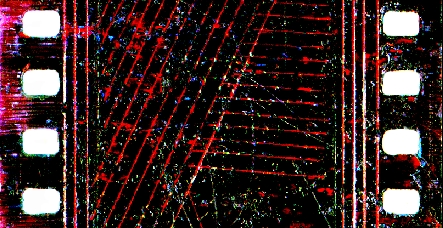from Cinegraphic.net:
The Alchemy of Touch
story © Michael Betancourt, October 21, 2004 all rights reserved.
URL: https://www.cinegraphic.net/article.php?story=20041021235637364

On the surface is where Rey Parla works to make his movies by hand, based on his physical, immediate response to the scratched/painted layers of his marks on that film. His haptic approach is flexible: it explores the physical character of its objects as objects, not as symbolic representations. This is a distinctly non-verbal approach to making movies. It does away with language in order to document a more immediate, direct encounter with the movie: the many tiny pictures that are the film itself.

Parla starts with normal motion picture film, and gradually reworks the photographed images so they become something entirely different, allowing the original movie to vanish entirely. In the course of making a movie, he builds the new image up from traces—the remains of each touch in making each movie. These layers become the finished movie an audience sees.
“Haptic” is the right word for this approach—a process that proceeds by touch instead of following a predetermined script. The guiding principle is attention to the specific, particular details of the immediate moment. It is the opposite of the architectural approach common to dramatic film where a script determines the entirety in advance, and every image is planned before starting to make the movie. The haptic approach is more common in painting than in movies because it is intimately connected to the act of making the image.
For the audience, these movies present a visceral experience that is more than just a layering of marks and effects. Seeing one of his movies in a theatrical setting communicates an emotional experience grounded in the shared, communal act of watching a movie in a darkened theater. Even though the movies emerge gradually from a personal encounter, the screening transforms the accumulated personal encounter into a performance.
These movies can be considered “emotional memory documents.” Layers of images combined with varying degrees of motion and sound create sensory experiences in the viewer. As a result, the spectator experiences their own memories and emotional archive, guided by what they see and hear in the movie. Parla’s gesture begins with the creation of single images that stretch beyond the individual projected frame, to create a spectral fusion of past experiences and the immediate act of viewing the movie.
This experience can be intense or meditative, depending on which movie the audience sees. By insisting on a connection between the thinking, interpreting mind and the physical body that sees and feels, these abstract films produce visceral responses for some viewers. His use of vivid color is immediately engaging, while sound provides an acoustic counterpoint to the visual, inviting deeper and more complex associations not immediately apparent visually. Traditional musical forms like the rumba or tango tie the visual dance to its origins in the traces and marks of graffiti art in the Latin culture of Miami.
Parla’s first scratch film, Sporadic Germination, contains embedded images of graffiti around Miami, overlaid, obscured re-written by the physical marks—another form of graffiti—that weave through the 3 minute super-8 film. He is interested in the gesture of human markings and their place in history. The movie was initially inspired by tracing the history of graffiti writing to the cave paintings in Lascaux, France and Altamira, Spain. It was an experiment in trying to make a connection between film and his personal experiences with graffiti writing as a child.
This film uses painting on film, found sounds and the graphic techniques of scraping, scratching, and scoring the film base as an attempt to create a viewing experience documenting the psychological, global displacement of an international youth subculture: graffiti writing. Sporadic Germination is a personal album of images that encourages questioning and lively conversation. Much of the movie includes faded images of actual Miami graffiti writers painting at unidentified and abandoned construction sites, imagery that is deeply embedded in the graphic patterns of scratches and marks that fill the movie.
Parla’s working process has an immediate quality to it. He is engaged in an exploration of how movies can serve to document experiences beyond the photographic, and then serve as a vessel for an audience to have their own encounter. The haptic approach is an attempt to incorporate his personal subjectivity literally into the physical nature and form of the images themselves: Parla’s work acts as a psychological document of his own mind and working processes.
stills from Rumba Abstracta used with permission.
Copyright © Michael Betancourt October 21, 2004 all rights reserved.
All images, copyrights, and trademarks are owned by their respective owners: any presence here is for purposes of commentary only.